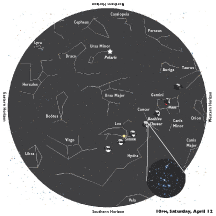The Buzz in the Sky
With no stingers, you won’t want to miss these bees
Look for Saturday’s first-quarter moon high in the southern sky at sunset, at 7:42, with Mars a little over one degree to the south. In the center of the constellation Gemini, Mars shines just a little brighter than Pollux or Castor but appears as a steady light as opposed to the flickering stars.
Sunday evening, the moon buzzes through Cancer and to the east of the Beehive Cluster. Cancer is a faint constellation, but the Beehive is one of the most easily visible deep-space objects. Scientifically called M44, for Messier Object 44, the Beehive is situated at the center of Cancer, halfway between Regulus in Leo and Pollux in Gemini. You can see it with the unaided eye as a hazy blob, although even small binoculars will reveal many of the hive’s bees.
Galileo first aimed his telescope at the Beehive Cluster in 1609, discovering that it “is not one star only, but a mass of more than 40 small stars.” Today, the Hubble Space Telescope, more than 100 million times more sensitive than Galileo’s own, has identified upward of 350 stars.
Although a compact blur from our vantage 580 light years away, the Beehive Cluster spans nearly 10 light years. It is about 400 million years old, young for stars, which is why these appear so distinctly blue.
Saturn shines high in the south in the evening, with the fainter blue-white star of Regulus less than three degrees to the east. The waxing gibbous moon joins the two Monday and Tuesday.
Jupiter blazes in the southeast before dawn, the brightest object now that Venus has disappeared amid the glare of the rising sun.
Tidelog®
Illustration: © Copyright 1925 M.C. Escher/Cordon Art-Baarn-Holland; Graphics: © Copyright 2007 Pacific Publishers. Reprinted by permission from the Tidelog graphic almanac. Bound copies of the annual Tidelog for Chesapeake Bay are $14.95 ppd. from Pacific Publishers, Box 480, Bolinas, CA 94924. Phone 415-868-2909. Weather affects tides. This information is believed to be reliable but no guarantee of accuracy is made by Bay Weekly or Pacific Publishers. The actual layout of Tidelog differs from that used in Bay Weekly. Tidelog graphics are repositioned to reflect Bay Weekly’s distribution cycle.Tides are based on National Oceanic and Atmospheric Administration and are positioned to coincide with high and low tides of Tidelog.
